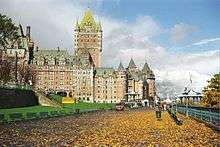Canada's grand railway hotels

Canada’s railway hotels are a series of five-star grand hotels across the country, each a local and national landmark, and most of which are icons of Canadian history and architecture. Each hotel was originally built by the Canadian railway companies, or the railways acted as a catalyst for the hotel’s construction. The hotels were designed to serve the passengers of the country's then expanding rail network and they celebrated rail travel in style.
Architecture
Many of the railway hotels were built in the "château style" (also termed the “neo-château” or "châteauesque" style), which as a result became known as a distinctly Canadian form of architecture. The use of towers and turrets, and other Scottish baronial and French château architectural elements, became a signature style of Canada’s majestic hotels. Architects also used the style for important public buildings, such as the Confederation and Justice buildings in Ottawa. In later years, the railway companies departed from the château style for some of their properties, notably with the construction of Winnipeg's Royal Alexandra Hotel in 1906; the Palliser Hotel in Calgary, built in 1914; and the elaborate second Hotel Vancouver, designed in grand Italianate style, unlike any of the previous Canadian railway hotels.
History

Canada's first grand railway hotel, the Windsor Hotel in Montreal, opened in 1878. Although it was not owned by a railway company, it was built to serve railway visitors from nearby Windsor Station. Given its location next to Montreal's main train station, the Windsor served for years as the permanent residence of executives of both the Canadian Pacific Railway and Grand Trunk Railway.
The railways' development role in the construction and operation of large hotels was inaugurated with Canadian Pacific Railway's opening of the Hotel Vancouver on May 16, 1888. This was the first of three railway-owned hotels by that name in Vancouver. Two weeks later, the Canadian Pacific Railway officially opened the Banff Springs Hotel on June 1, 1888. CPR president William Cornelius Van Horne had personally chosen the site in the Rocky Mountains for the new hotel. He envisioned a string of grand hotels across Canada that would draw visitors from abroad to his railway. Van Horne famously remarked: “If we can’t export the scenery, we’ll import the tourists.”[1] The original Banff Springs Hotel, of wooden construction, was destroyed by fire in 1926 and replaced by the present structure.[2]
Canadian Pacific Hotels next built the Château Frontenac in Quebec City, which quickly came to be the symbol of the city. It was designed to rival any hotel in Europe. Its elevated location overlooking the city also made it a readily identifiable landmark as viewed from passing trains as well as ships plying the waters of the Saint Lawrence River en route to or from Montreal. Place Viger followed in Montreal, followed by The Empress in Victoria, British Columbia, and the Château Lake Louise in Alberta. The largest of these hotels is the Royal York in Toronto, which opened in 1929. The CPR’s main competitor, the Grand Trunk Railway, was not prepared to leave the field solely to its rival. It also determined to build a chain of luxury hotels across the country, which it did in the château style. The GTR built the Château Laurier in Ottawa in 1912, with the Fort Garry Hotel in Winnipeg and the Hotel Macdonald in Edmonton following in 1913 and 1915 respectively.

The GTR was amalgamated into the Canadian National Railway in 1920. During the decades that followed, the CPR and the CNR continued to expand their competing hotel chains across the country. The Queen Elizabeth Hotel in Montreal, built in 1958 over that city’s Central Station, was perhaps the last true railway hotel built in Canada. Both railways continued to open new establishments in subsequent years, although none had any connection to the railways, except through their ownership.
In 1988, Canadian Pacific acquired the CNR hotels. For the first time, many of Canada’s railway hotels were operated by the same company. In 1999, Canadian Pacific Hotels became Fairmont Hotels and Resorts, using the name of a company it had recently acquired. Although Fairmont continues to operate many of Canada’s landmark hotels, a number of the historic railway hotels, such as Saskatoon's Delta Bessborough, are owned and managed by other hotel chains.
Inventory
See also
| Wikimedia Commons has media related to Canada's grand railway hotels. |
References
- ↑ Chisholm, Barbara, ed., Castles of the North: Canada’s Grand Hotels (Toronto: Lynx Images Inc., 2001) (ISBN 1-894073-14-2)
- ↑ "History of The Fairmont Banff Springs". Archived from the original on 11 February 2015. Retrieved 2 May 2015.
- Knowles, Valerie, From Telegrapher to Titan: The Life of William C. Van Horne (Toronto: Dundurn Group, 2004) (ISBN 1-55002-488-4)
